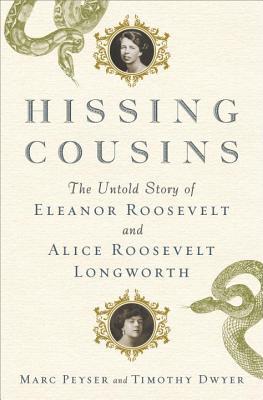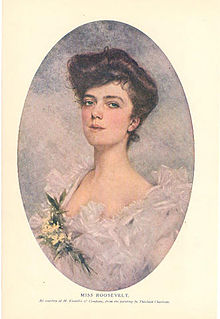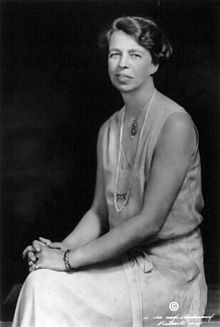 Hissing Cousins: The Untold Story of Eleanor Roosevelt and Alice Roosevelt Longworth by Timothy Dwyer, Marc Peyser
Hissing Cousins: The Untold Story of Eleanor Roosevelt and Alice Roosevelt Longworth by Timothy Dwyer, Marc Peyser Formats available: hardcover, paperback, ebook, audiobook
Pages: 352
Published by Nan A. Talese on March 31st 2015
Publisher's Website, Amazon, Barnes & Noble, Kobo, Bookshop.org
Goodreads
A lively and provocative double biography of first cousins Eleanor Roosevelt and Alice Roosevelt Longworth, two extraordinary women whose tangled lives provide a sweeping look at the twentieth century.
When Theodore Roosevelt became president in 1901, his beautiful and flamboyant daughter was transformed into "Princess Alice," arguably the century's first global celebrity. Thirty-two years later, her first cousin Eleanor moved into the White House as First Lady. Born eight months and twenty blocks apart from each other in New York City, Eleanor and Alice spent a large part of their childhoods together and were far more alike than most historians acknowledge.
But their politics and temperaments couldn't have been more distinct. Do-gooder Eleanor was committed to social justice but hated the limelight; acid-tongued Alice, who became the wife of philandering Republican congressman Nicholas Longworth, was an opponent of big government who gained notoriety for her cutting remarks (she famously quipped that dour President Coolidge “looked like he was weaned on a pickle”). While Eleanor revolutionized the role of First Lady with her outspoken passion for human rights, Alice made the most of her insider connections to influence politics, including doing as much to defeat the League of Nations as anyone in elective office.
The cousins themselves liked to play up their oil-and-water relationship. “When I think of Frank and Eleanor in the White House I could grind my teeth to powder and blow them out my nose,” Alice once said. In the 1930s they even wrote opposing syndicated newspaper columns and embarked on competing nationwide speaking tours. Blood may be thicker than water, but when the family business is politics, winning trumps everything.
Vivid, intimate, and stylishly written, Hissing Cousins finally sets this relationship center stage, revealing the contentious bond between two political trailblazers who short-circuited the rules of gender and power, each in her own way.
My Review:
A fascinating dual biography of the first two female power-brokers in the U.S., along with a peek inside one of the longest-running First Families in U.S. history, and with a look at the way the rich and famous lived in what has often been called “the American Century”.
We think of them as being from two different eras, but they were not. While Alice Roosevelt Longworth was the daughter of Theodore Roosevelt, the 26th President of the U.S., and Eleanor Roosevelt was the wife of Franklin Delano Roosevelt, the 32nd President of the U.S., Alice and Eleanor were not just cousins, but they were born in the same year – 1884.
And for two women who on the surface seem to be exact opposites, there are a surprising number of similarities – and some absolutely fascinating differences.

Alice Roosevelt Longworth was a lot like Princess Di or the Kardashians. She was famous because of who she was, not what she did. When her father Teddy Roosevelt became president she was 15 years old and rebellious into the bargain. And she loved the publicity brought by her rebelliousness. The press loved her, she made great copy, and they dubbed her “Princess Alice”.
A color was named for her, Alice Blue, and a hit Broadway song was named for that color, “Alice Blue Gown” in the musical Irene. While Alice was famously everywhere, her cousin Eleanor was shy, retiring and still far from growing into the woman and the reformer that she would later become.
And it’s entirely possible that both girls “set their caps” for their cousin Franklin, but Eleanor caught him. Alice married Nicholas Longworth, a Congressman from Ohio who eventually became Speaker of the House. Longworth was the first in a long line of older, politically powerful men that Alice loved, and whose careers she both nurtured and skewered.
In her old age, Alice became famous for the saying, “If you can’t say something good about someone, sit right here by me.” Alice was often viciously malicious throughout her long life, and her cousin Eleanor was a frequent target. Alice enjoyed being bad, and Eleanor was always frightfully good.

Eleanor Roosevelt could easily have been just like Alice – famous for being the President’s wife (instead of his daughter) and not known for much else. Instead, Eleanor Roosevelt became one of the most famous American women of the 20th century. FDR’s polio in 1921 forced Eleanor to become the more active political campaigner, while FDR ran for Governor of New York, and after two terms, President of the United States. It was impossible to be shy and retiring on the campaign trail, even in the late 1920s and early 1930s. Eleanor was forced out of her shell, and she found the confidence to not only campaign for her husband, but to champion the reform causes that were near and dear to her own heart, even if her husband disagreed with them. Eleanor became the quintessential upper class do-gooder, but unlike many of her type, she didn’t just pay causes lip-service, she got stuff done.
Alice and Eleanor were like the Wicked Witch of the West and Glinda the Good Witch in The Wizard of Oz – always on opposite sides, but still very much family.
Mrs. Democrat (Eleanor) and Mrs. Republican (Alice) wielded their very real power in completely different ways. But they were alike in their background, in their tragedies, and in being the first women to have so much power at their own fingertips.
Reality Rating A: Eleanor Roosevelt is a historical figure that everyone thinks they know about. Alice Roosevelt Longworth, on the other hand, at the beginning of the 20th century was much more famous (and infamous), than her cousin Eleanor ever thought of being.
That the situation reversed had a lot to do with the different ways that these women wielded power, and their often divergent paths in life, in spite of, or perhaps because of, their very similar beginnings.
We often forget that Eleanor Roosevelt was Franklin Roosevelt’s cousin as well as his wife. Roosevelt was both her maiden name and her married name! And in our current era of political dynasties, the Kennedys, the Bushes,, and the Clintons, we sometimes forget that the Roosevelts got there first. Between 1900 and FDR’s death in 1945, there were 12 presidential elections, and either TR or FDR was on the ballot 8 of those 12 times. Only 1908, 1916, 1924, 1928 lacked a Roosevelt on one ticket or the other. Not even the Bushes have been that dominant, whether in success or failure.
In the first half of the 20th century, the Roosevelts were always in the news.
The story in Hissing Cousins isn’t just the news that they made, but how both women achieved their fame (or notoriety) and what they did with it.
While they both became power-brokers, they went about it entirely differently. Sharp and sparkling (and often maliciously vicious) Alice always worked behind the scenes. Her whispers were like a knife in the dark to many a political career, including on her own side. Eleanor was a public-minded and public-spirited reformer, she came out from behind her husband’s shadow and held office in her own name and for her own causes. Eleanor emerged from her own shyness to hold forth confidently in the sunshine. Alice liked publicity for herself, but she worked for her party behind the scenes.
Which of them was more truly influential is a bit hard to tell. While every President from TR to Gerald Ford met with Alice Roosevelt Longworth, what was said, what advice she gave, was not recorded. It was not intended to be. Although Richard Nixon was a favorite of Alice’s, it’s a pity that she didn’t meet with him in the White House, we might have recordings. But “Princess Alice” made the politicians court her, not the other way around.
Alice’s power was a kind of soft power, and the type that women historically held. Her power was the power of influence and gossip. She had good political instincts, and she used them to help those she favored, but it wasn’t the kind of power that led to speechmaking or officeholding of her own. She worked best from the shadows.
Eleanor Roosevelt’s use of power is the model we see today. She held offices of her own, admittedly mostly after FDR died. But she worked in her own name, particularly for the United Nations. What she said, what she did, was recorded as hers. Her successes and failures were also publicly hers.
But seeing their lives laid out side by side, as they each struggled for the limelight, and struggled with their children and their especially domineering mothers in law, we see how alike they are amongst their differences. And it makes for a fascinating story.
